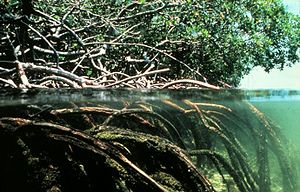Mangroves: Difference between revisions
| Line 40: | Line 40: | ||
====Nitrogen Fixers==== | ====Nitrogen Fixers==== | ||
Proteobacteria | |||
====Sulfate Reducers==== | ====Sulfate Reducers==== | ||
Revision as of 05:33, 12 April 2010
Introduction
Mangroves are highly productive ecosystems. Mangrove swamps cover roughly 60-75% of the world’s tropical coastlines, distributed over more than 112 countries with a total area near 181,000km2. Since mangroves are located in the tidal regions of the coastal shorelines, they have high levels of salinity. Also because they are on the coast and have highly developed root systems they are a deterent to shoreline erosion and can lessen the effects of tidal waves such as tsunamis and storm surges. Mangrove litter decomposition and the nutrient release which accompanies it is a vital part of the function of adjacent coastal ecosystems. Sediment microorganisms play important roles in the mangrove ecosystem and make essential contributions to its productivity.
Physical environment
Describe the physical and chemical characteristics of the environment, using as many sections/subsections as you require. Look at other topics available in MicrobeWiki. Which involve processes similar to yours? Create links where relevant.
Vegetation
The vegetation of the mangrove swamps is likely their most indicative feature. Of the recognized 110 mangrove species, only about 54 species in 20 genera from 16 families constitute the "true mangroves", species that occur almost exclusively in mangrove habitats. These mangrove species have adapted in many different ways, such as limiting salt uptake, surviving in low oxygen conditions, limiting water loss, and even increasing the survival rate of their offspring.
Sediment
In the sediment of most mangrove swamps there is a distinction between two primary layers. The majority of the sediment is anaerobic where there is a lack of oxygen. On top of that is a thin aerobic layer where oxygen is available.
Biological interactions
Are there important biological interactions that are important in this environment? Do these interactions influence microbial populations and their activities? How do these interactions influence other organisms? Describe biological interactions that might take place in this environment, using as many sections/subsections as you require. Look at other topics available in MicrobeWiki. Create links where relevant.
Subsection 1
Subsection 1a
Subsection 1b
Subsection 2
Microbial processes
What microbial processes define this environment? Describe microbial processes that are important in this habitat, adding sections/subsections as needed. Look at other topics in MicrobeWiki. Are some of these processes already described? Create links where relevant.
Nitrogen Fixation
Nitrogen fixation is the process of conversion of gaseous forms of Nitrogen [N2] into combined forms such as ammonia or organic nitrogen. This process is generally carried out by some bacteria or cyanobacteria. N-fixation has had increased rates associated with dead and decomposing leaves, but in mangrove sediment is likely to be hindered by a limited supply of energy sources.
Sulfate Reduction
Generally a mangrove sediment consists of anaerobic conditions with an overlying aerobic zone. In the aerobic zone decomposition of organic matter usually follows the pathway of respiration, however in the underlying anaerobic zone decomposition occurs mainly through sulfate reduction. Sulfate reduction accounts for nearly 100% of the total CO2 emissions from the mangrove sediment.
Phosphate Solubilization
Phosphate usually precipitates in mangroves because of the large amount of cations in the interstitial water of mangrove sediments, which makes phosphorous largely inaccessible to plants. The phosphate solubilizing bacteria are a great advantage for mangrove plants because they are a source of soluble phosphorous. There is little research done on this particular group of bacteria in the marine environment; however it is speculated that the mechanism responsible for phosphate solubilization probably involves the production of organic acids, which could act as chelators displacing metals from phosphate complexes.
Key Microorganisms
What kind of microbes do we typically find in this environment? Or associated with important processes in this environment? Describe key groups of microbes that we find in this environment, and any special adaptations they may have evolved to survive in this environment. Add sections/subsections as needed. Look at other microbe listings in MicrobeWiki. Are some of the groups of microbes from your environment already described? Create links to those pages. Specific microbial populations will be included in the next section.
Examples of Microorganisms
Phosphate Solubilizers
Nitrogen Fixers
Proteobacteria
Sulfate Reducers
Examples of organisms within the group
List examples of specific microbes that represent key groups or are associated with important processes found in this environment. Link to other MicrobeWiki pages where possible.
Current Research
Enter summaries of recent research here--at least three required
References
Edited by student of Angela Kent at the University of Illinois at Urbana-Champaign.

